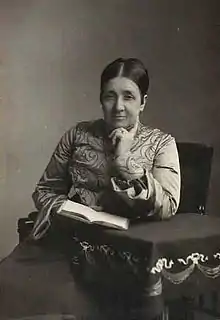Astrid Stampe Feddersen
Astrid Stampe Feddersen, usually known as Astrid Stampe, (1852–1930) was a Danish women's rights activist and author alongside her sister Rigmor Stampe Bendix. Stampe joined the women's movement early on and from 1883 to 1887, she was on the board of the Danish Women's Society, playing an active part in work on women's issues.
Astrid Stampe Feddersen | |
|---|---|
 | |
| Born | December 19, 1852 |
| Died | April 16, 1930 (aged 77) Copenhagen, Denmark |
| Relatives | Rigmor Stampe Bendix (sister) Christine Stampe (grandmother) |
| Honours | Gold Medal of Merit, 1922 |
As an activist, Stampe authored several pamphlets in support of her cause, including: Kvindesagen (1886)[1] and Kan Kvindesagen og Sædelighedssagen skilles ad? (1888).[2]
Biography
Born on December 19, 1852 at Christinelund near Vordingborg, Stampe was of noble ancestry. She was the daughter of Henrik Stampe (1821–1892), a Chamberlain and Hofjægermester. Because of her father's rank, she was born with the title of baroness. Other family member of note include her grandmother, Christine Stampe, and her great grandfather, Jonas Collin, who was Hans Christian Andersen’s fatherly benefactor.[3] Stampe's personal tutors, her upbringing in Copenhagen, and her educational travels gave her a cultured background. She learned Swedish, French and English though as a result of the Schleswig wars, she did not learn German.
In 1881, she married Gustav Hakon Valdemar Feddersen (1848–1912). In the course of his career, Gustav was an assistant to the Ministry of the Interior, anAmtman in Ringkjøbing, and later for the Diocese of Lolland-Falster.[4] The couple had four children: Hakon (born 1883), Jonna (1884), Gudrun (1887), and Ingrid Kristine (1888).[5]
Stampe took part in the fight against prostitution and fought for greater equality between men and women, including unmarried women.[6] Her husband supported her feminist interests and her membership of the Copenhagen chapter of the Danish Women's Society, beginning in 1882. She successfully sought to reinforce the association's position and extend its influence to the provinces.[7] In April of 1883, she became a member of the board of the Women's Society a position which she held until 1887, though she was re-elected to the board in 1903. She was chairman of the society from 1913 until 1918.[7][8] In this position, she chaired the first Nordic meeting on women's rights in Copenhagen in 1914.[9][10]
Stampe wrote an article in Højskolebladet which called for the founding of a Danish society for "friends of Iceland," much like the already existing German society Islandsfreunde. In 1916, her proposed society became the Danish-Icelandic Society (Danish: Dansk-Islandsk Samfund).[11] Stampe was awarded the Gold Medal of Merit on her 70th birthday in 1922.[9] She died on April 16, 1930 in Copenhagen. She was buried at Jungshoved Cemetery, though her grave is no longer there.[12]
Bibliography
- Kvindesagen, 1886
- Kan Kvindesagen og Sædelighedssagen skilles ad?, 1888
- Om Kvindesagen: Et Foredrag, 1907
- Frue og Frøken, 1911
- Vort Modersmaal, 1912
- Dansk Navneskik, 1914[13]
References
- Stampe, Astrid (1887). Kvindesagen: En kortfattet redegørelse. Smaaskrifter udgivne af Dansk Kvindesamfund (in Danish). Vol. 5 (4th ed.).
- Stampe Feddersen, Astrid (1888). Kan kvindesagen og sædelighedssagen skilles ad? (in Danish).
- "Astrid Stampe's Picture Book". Odense City Museums. Retrieved 30 December 2020.
- Westrin, Th., ed. (1917). Nordisk Familjebok: Konversationslexikon och Realencyklopedi (in Swedish). Vol. 26: Slöke–Stockholm. Stockholm: Nordisk Familjeboks Tryckeri. p. 967 – via Projekt Runeberg.
- Vammen, Tinne. "Astrid Stampe Feddersen (1852 - 1930)". Dansk Kvindebiografisk Leksikon (in Danish). Retrieved 30 December 2020.
- Fink, Janet; Lundqvist, Åsa (2010). Changing Relations of Welfare: Family, Gender and Migration in Britain and Scandinavia. Ashgate Publishing, Ltd. p. 44. ISBN 9780754678939.
- Tinne Vammen. "Astrid Stampe Feddersen (1852–1930)" (in Danish). Dansk kvindebiografisk leksikon. Retrieved 1 April 2014.
- Melby, Kari; Ravn, Anna-Birte; Wetterberg, Christina Carlsson (2009). Gender Equality and Welfare Politics in Scandinavia: The Limits of Political Ambition?. The Policy Press. p. 18. ISBN 978-1-84742-465-5.
- Brøndum-Nielsen, Johs.; Raunkjær, Palle, eds. (1927). Salmonsens Konversations Leksikon (in Danish). Vol. XXII: Spekulation–Søøre (2nd ed.). Copenhagen: J. H. Schultz. p. 133 – via Projekt Runeberg.
- "Astrid Stampe" (in Danish). Dansk Biografisk Leksikon. Retrieved 1 April 2014.
- "Meddelelser fra Dansk-Islandsk Samfund". Budbringer til Medlemmerne af Dansk-Islandsk Samfund (in Danish). Nr. 15: 6–7. January 1931. ISSN 2298-6308 – via Tímarit.is.
- "Astrid Stampe". gravsted.dk (in Danish). Retrieved 30 December 2020.
- Lous, Eva (1996). Dansk Kvindesamfunds Arkiv: Registrant over Dansk Kvindesamfunds Arkiv i Kvindehistorisk Samling (PDF) (in Danish). Århus: Statsbiblioteket i Århus. ISBN 8775072114 – via Royal Library, Denmark.